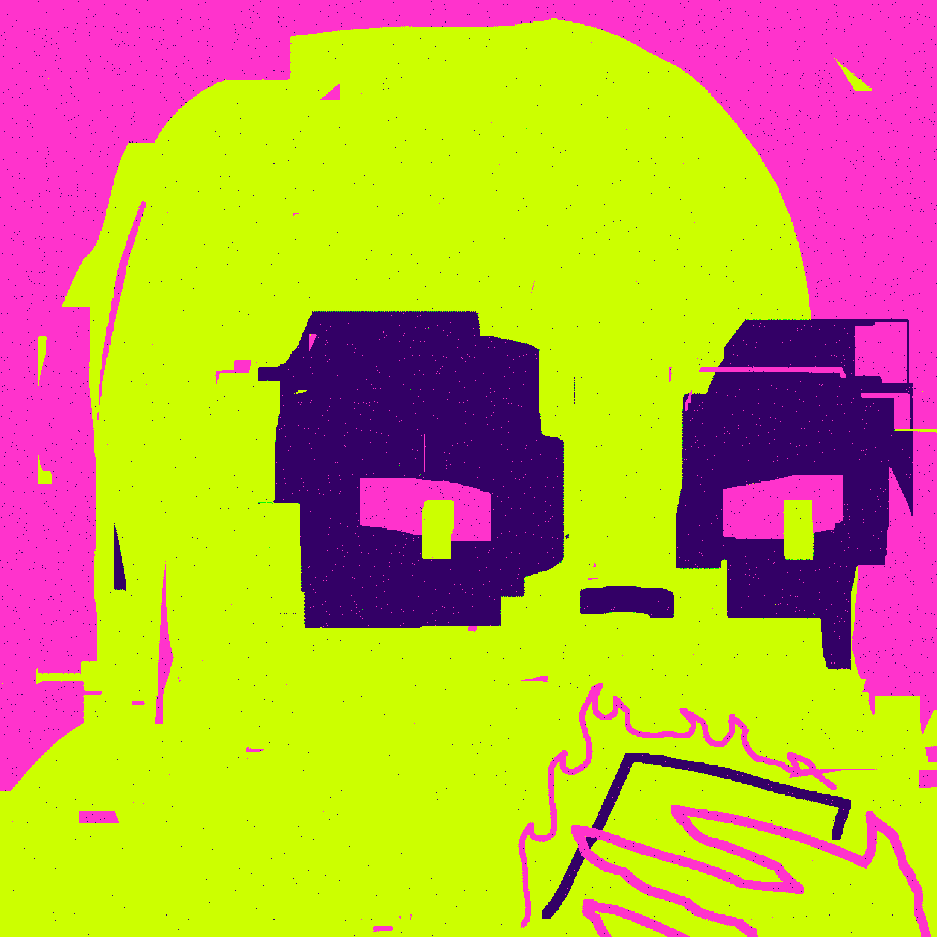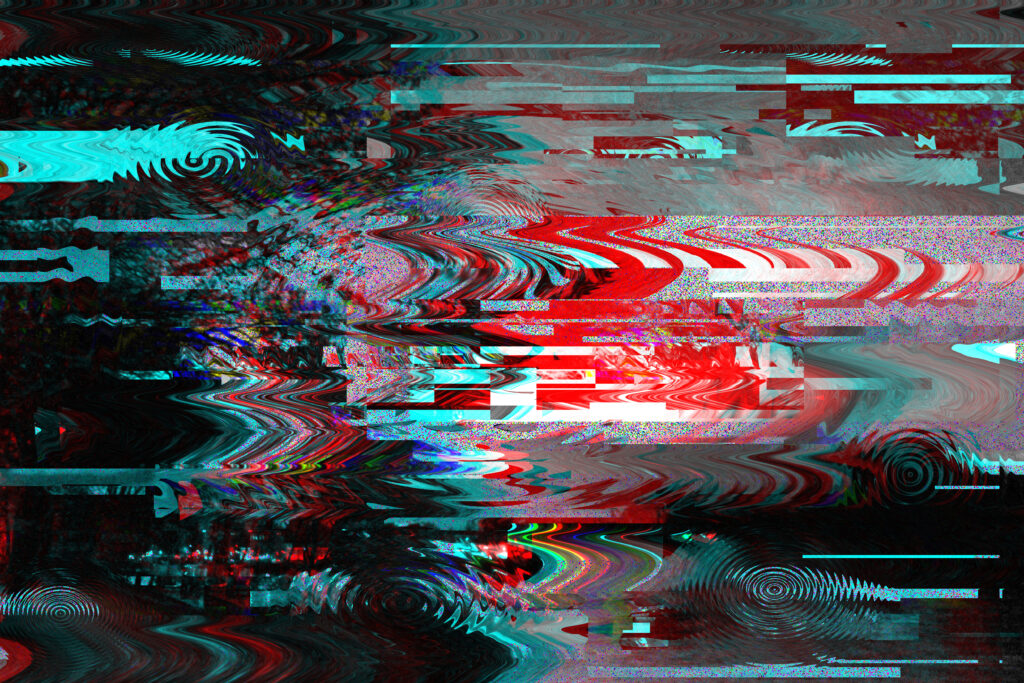Discover what is glitch art and why it’s popular in the NFT space in our guide.
When I hear the word ‘glitch,’ art certainly isn’t the first word that comes to mind. However, it turns out that for many artists, the glitch effect has become a source of rich artistic innovation.
The relatively new artistic trend known as glitch art has embraced errors and mistakes to create an unusual new digital art form. You’ve almost certainly come across it in adverts and music videos, possibly without even realizing it.
Glitch art combines random mistakes made by computer software with artistic control to create digital images, videos, and GIFs with unusual visual errors.
In this article, you’ll get all the information you need to understand what glitch art is, the art form’s history, how its created, and top NFT artists use the glitch effect in their work.
Table of Contents
The History of Glitch Art
A glitch is a brief interruption or error in digital files that display films, videos, music, and images. So naturally, most of the population didn’t encounter glitches until computers became more accessible in the second half of the 20th century.
As computer-generated graphics became part of the media landscapes in the 1970s, three pioneering artists, Raul Zaritsky, Jamie Fenton, and Dick Ainsworth, saw the potential glitching pixels could have to get their work into art galleries worldwide.
The three artists created a short glitch art video titled ‘Digital TV Dinner’ using a video game console and a VHS recorder in the late 1970s.
Although Digital TV Dinner looks pretty basic compared to the work of some of today’s glitch artists, it got the ball rolling and almost certainly changed the course of visual art for good.
Glitching caught on slowly in the art world, and in the 90s, it became more closely associated with the music industry. Glitch music came from accidental audio malfunctions such as a skipping CD, unwanted background noise, distortions, and vinyl scratches. One of the most renowned early innovators in glitch music was the Japanese musician Tone Yasunao who experimented in the late 20th century with various glitch effects on his tracks.
More recently, Tone, like many generative artists, has started incorporating artificial intelligence into his work, allowing him to take glitch effects to the next level. Following the turn of the century, glitch artists started to get organized, and in 2002, the first glitch art symposium was held in Oslo. The symposium brought together artists to share ideas about the burgeoning field of art, and now significant events are held almost every year worldwide.
Now that we know where glitch art comes from, we’re going to look at how artists the glitch moment and turn imperfection into carefully curated digital art.
Creating Glitch Art
Glitch art is created in various formats, including videos, still JPEG images, GIFs, and music. In its most basic form, glitch art involves capturing the moment a random error occurs. However, in reality, this is rare, and today, most artists directly manipulate digital data to create glitched images.
Glitch art is created using dozens of different methods; we’ll introduce you to the most popular methods.
1. Glitching Videos with Datamoshing
Datamoshing, also known as databending, is used to manipulate the data held within media files resulting in a distorted visual or auditory effect. The process involves removing specific frames that compose a video file to create errors in its transmission once the file is decoded. By removing frames, the layers that make up the video are confused, and the effect of this is a psychedelic mix of glitchy colors.
To get an idea of how datamoshing is used to make glitch videos check out A$SA Mob’s ‘Yamborghini High’ music video; this is a typical example of datamoshing being used to add glitch-style discoloration to a video. Another well-known example of datamoshing can be found in Kanye West and Kid Cudi’s ‘Welcome To Heartbreak’ music video, in which manipulated frames result in altered faces with washed-out features and bizarre patterns.
Attempting to code datamoshing manually would be extremely difficult; fortunately, the following software can help you get the hang of it even if you don’t have a degree in computer science:
2. Pixel Sorting
Digital images such as JPEGs and BMPs are created using millions of pixels, and if one of these little boxes of information makes a mistake, you get a glitch. Graphic designers and artists often create glitch effects with the help of algorithms and software.
Pixel sorting is a technique believed to have been invented by the digital artist Kim Asendorf. The process uses code to shift rows and columns of pixels within an image. Pixel sorting allows artists to keep the original outline of an image file but add a glitchy effect that distorts colors while blending borders between different on-screen objects into a smooth flowing pattern.
An excellent example of Pixel sorting was posted in a Medium article by Alex Manthei.
3. Light Leaks
Light leaks are an error that often surfaces while developing images created through analog photography – you know, the cameras we used before smartphones and digital SLRs. Even though light leaks are an unwanted glitch that used to ruin people’s holiday photos, some artists picked up on it as a potentially helpful glitching effect.
Light leaks create a mixing effect where colors seem to blend under the impact of a powerful beam of light. Artists, graphic designers, and even social media users are now going out of their way to incorporate light leaks into their work using specialized software and apps.
4. Grainy Imagery
One of the earliest forms of glitching occurred when VHS tapes became widely available to consumers. If you’ve ever tried to play an old video tape, you may have found that occasionally the video would be covered in a grainy gray color as the pixels experience a burst of errors.
Grainy pixelation might be one of the reasons that DVDs replaced VHS tapes, but the glitch art community has fondly revived this glitching effect.
5. Distortion
Distortion is one of the earliest forms of glitch art; the process involves disrupting a device display, usually using magnetic fields.
Name June Paik, according to his Wikipedia page, was a Korean-American artist who widely experimented switch using magnetic fields to distort digital images and videos. Paik interfered with analog television displays using powerful magnets in the late 1960s. One of Paik’s early pieces can be seen at the Whitney Museum of American Art in New York or on the Museum’s website.
Distortionary glitch art has developed since Paik, and today most artists use compression artifacts instead of physically damaging devices. A compression artifact can be applied to digital images, videos, and music; it essentially discards some of the file’s data to make it easier to store; by removing some of the data, distortions can occur, resulting in glitch effects.
If you’re a budding visual artist who thinks this section’s glitch aesthetics would add an element of flare to your digital art or videos, then you should consider using the glitch art software we suggest below.
Top Glitch Art Software
You don’t need to be a computer scientist or professional digital artist to start creating glitch art; here are five software options to help you make your first glitch GIF, video, or JPEG:
1. PowerDirector (Windows/Mac)
PowerDirector is a video editing software loaded with many glitch effect tools. The tools offered by PowerDirector are easy to use even if you haven’t had much experience in glitching, making it ideal for video editors looking to mix up their style.
Another advantage of using PowerDirector is that it offers a decent library of glitch templates that you can add to your files with minimal hassle.
2. Photoshop (Windows/Mac)
Adobe’s Photoshop is the go-to editing software for millions of artists, photographers, and digital artists beyond the standard features we’ve come to expect from this software; it also offers a wide range of glitching tools.
Some of the most recognized Photoshop glitch tools include:
- Wave Filter
- Layer Saturation
- Line Distortion
- Color Separation
- Pixel Sorting
Although Photoshop isn’t designed especially for glitching, the developer has already successfully added glitching tools, and we can expect more features to come as glitching becomes more popular. Furthermore, due to the popularity of Photoshop, YouTube is littered with tutorials showing you how to make the best of the effects; for example, Spoon Graphics, a channel with over 500K subscribers, has a video dedicated to Pixel Sorting on Photoshop.
3. PhotoMosh
PhotoMosh is the ideal platform for beginners interested in creating glitch GIFs or adding glitch effects to their video clips. With over 25 different effects to choose from and a range of user-friendly tools, this software will help you take you to progress quickly from beginner glitch artist to expert in next to no time.
If you’re looking for some inspiration before you dive into creating glitchy GIFs, JPEGs, and videos, then the best place to turn is the portfolios of some of the most prolific glitch artists in the industry.
Leading Glitch Art Creators
Although glitch art is yet to break out as a genuinely mainstream art form, several highly-respected digital artists have created extensive glitch art portfolios and even had their work displayed in some of the most important art galleries in the world. So, Let’s look at five of the biggest names in glitch art.
1. Jamie Fenton
Jamie Fenton was a video game programmer who played a pivotal role in the success of the Chicago computer graphics programming scene in the 1980s.
Fenton created one of the earliest examples of glitch video when, alongside his colleagues, he produced the short video titled Digital TV Dinner in 1978 using analog and digital errors generated by corrupted data.
2. Daniel Temkin
Daniel Temkin is a digital artist who has applied programming languages to his work, exploring the potential cooperation between human artists and algorithms. A lot of his work can be found on his
While Temkin has contributed to several branches of the art world over the last decade, some of his most notable work has been focused on glitch art.
Temkin’s Glitchometry used a glitching tool to create a series of pieces that blend psychedelic shapes and colors into flowing canvases.
Glitchometry was created using generative software that made decisions without direct input from Temkin, meaning he had no control over the exact outcome; if this approach to art interests you, we suggest you read our Guide To Generative Art.
One of the most inspiring pieces in the collection is ‘Glitchometry Circles #4’; the power of the glitching effect is evident here as the layers blend across one another while deeply colored circular shapes fade across the canvas.
3. Rosa Menkman
Rosa Menkam is a Dutch artist whose work has emphasized the effect of glitches both in analog and digital media formats. The best place to get an idea of Menkam’s work is on her Flickr, where she regularly uploads her glitch work.
One of her most memorable collections is the ‘Vernacular of File Formats, which is composed of over 50 images of haunting female figures glitched using the data compression technique. Beyond creating glitch art, Menkam has played a significant role in the theory behind the field and argued in her book ‘Network Notebook #04: The Glitch Moment(um)’ that glitch art is its own art form within contemporary art space.
4. Phillip Stearns
Phillip Stearns is an artist and designer based in New York who combines physical fabrics with digital art. Stearns’ interest in glitch art led him to crowdfund the ‘Glitch Textiles’ design label, which Stearns used to bring glitch art into the physical world.
The Glitch Textiles label has been a hit, and Stearns has released and sold several differently-themed glitch art textiles on his online store. Although all the glitchy textiles are eye-catching, one of the most impressive collections is the ‘Classic Jacquard Woven Cotton Throw Blankets.’
The throw blankets that sell for over $200 each combine jagged lines and infinitely repeating square shapes blended using the Gradients glitching tool.
5. XCOPY

XCOPY is an anonymous NFT glitch artist who’s sold his dystopian-style art for millions of dollars, on NFT marketplaces like OpenSea and Rarible, with the highest bidders often including celebrities as well known as the rapper Snoop Dogg. XCOPY’s GIFs often tap into the sinister side of modern society using flashing glitchy colors combined with dark scenes and characters to catch your attention.
If you’re interested in learning more about the most relevant yet anonymous glitch artist, check out our in-depth XCOPY profile.
Final Thoughts on What is Glitch Art
Glitch art is the ultimate example of how human creativity knows no bounds; what started with mistakes made by first-generation computer technology has grown into a contemporary art form. Artists have found the power that computer errors have, and this field will undoubtedly continue to expand as more digital artists start exploring the creative power of computer glitches.


